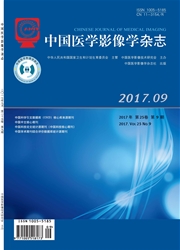

 中文摘要:
中文摘要:
目的比较三阴性乳腺癌(TNBC)与非三阴性乳腺癌(NTNBC)的钼靶X线及超声特征,提高TNBC的影像诊断水平。资料与方法根据免疫组化检测结果,将387例乳腺癌患者分成TNBC组54例和NTNBC组333例,回顾性分析两组患者的钼靶X线图像、超声声像图及临床病理资料。结果 TNBC组肿瘤组织学分级高,浸润性导管癌Ⅲ级明显多于NTNBC组(χ2=47.009,P〈0.001);腋窝淋巴结转移率高于NTNBC组(χ2=4.658,P〈0.05)。乳腺钼靶X线显示,TNBC组主要表现为肿块(37例,69.8%),钙化少见(10例,18.9%),肿块多呈圆形或椭圆形(28例,62.2%),边缘清晰(16例,35.6%),毛刺征少见(5例,11.1%);NTNBC组多表现为肿块伴钙化(138例,42.1%),形态多不规则(119例,46.5%),毛刺征多见(77例,30.1%),两组在肿块、钙化、形态及边缘方面差异有统计学意义(χ2=24.618、19.889、32.605、21.102,P〈0.001)。超声显示,TNBC组主要表现为肿块(52例,96.3%),钙化少见(5例,9.3%),肿块多呈圆形或椭圆形(27例,51.9%),边缘清晰(25例,48.1%),毛刺征少见(3例,5.8%),肿块后方回声衰减少见(5例,9.6%);NTNBC组多表现为肿块(318例,96.1%),钙化多见(135例,40.8%),形态多不规则(243例,76.4%),毛刺征多见(76例,23.9%),肿块后方回声衰减者多见(78例,24.5%),两组在肿块钙化、形态、边缘、肿块后方回声方面差异有统计学意义(χ2=19.006、18.339,P〈0.001;χ2=16.170、8.429,P〈0.05)。结论在钼靶X线和超声中,TNBC主要表现为边缘清晰的圆形或椭圆形肿块,肿块后方回声衰减少见,更倾向于良性肿瘤的影像学特点;NTNBC主要表现为形态不规则的毛刺边缘肿块,钙化多见,上述影像学特征有助于TNBC的早期诊断。
 英文摘要:
英文摘要:
Purpose To compare the mammography and ultrasound imaging features of triplenegative breast cancer(TNBC) and non-triple-negative breast cancer(NTNBC), and to improve TNBC diagnosis. Materials and Methods Using immunohistochemical staining technique, 387 patients with pathologically confirmed breast cancer were divided into TNBC group(n=54) and NTNBC group(n=333). Mammography and ultrasound findings as well as pathological data were retrospectively reviewed. Results TNBC was associated with higher tumor grades. There were significantly more grade III infiltrating ductal carcinomas and axillary lymph node involvement in TNBC group than in NTNBC group(χ2=47.009, P0.001; χ2=4.658, P0.05). On mammography, TNBC most frequently presented with a mass(n=37, 69.8%) and was less associated with microcalcifications(n=10, 18.9%). TNBC masses were mostly round or oval(n=28, 62.2%) with circumscribed margin(n=16, 35.6%). Spiculated margins were rare(n=5, 11.1%). NTNBC most frequently presented as a mass with calcifications(n=138, 42.1%), and was more irregular in shape(n=119, 46.5%). Spiculated margins were common(n=77, 30.1%). There was statistically significant difference between these two groups in mass, microcalcification, shape and margin(χ2=24.618, 19.889, 32.605 and 21.102, P0.001). On ultrasonograhy, TNBC most frequently presented as a mass(n=52, 96.3%) with less microcalcifications(n=5, 9.3%). TNBC masses were more frequently round or oval(n=27, 51.9%) with circumscribed margins(n=25, 48.1%). Spiculated margins were rare(n=3, 5.8%). TNBC was less likely to show attenuating posterior echoes(n=5, 9.6%); NTNBC most frequently presented as a mass(n=318, 96.1%) with microcalcifications(n=135, 40.8%). NTNBC masses were more frequently irregular in shape(n=243, 76.4%) with spiculated margins(n=76, 23.9%). NTNBC was more likely to show attenuating posterior echoes(n=78, 24.5%). There was statistically significant difference b
 同期刊论文项目
同期刊论文项目
 同项目期刊论文
同项目期刊论文
 期刊信息
期刊信息
